I have twin inboard Palmer marinized International 392 gas engines in the boat.
Over the years I have had a few E10 related problems.
But they were mostly overcome by using Marine Stabil.
Ethanol facilitates the growth of acetobacter in the gas, which creates acids and degrades metal parts and the fuel. Use a stabilizer as it kills the bugs growing in today's Ethanol laced gasoline.
Another improvement which I recently made is to use a VOPR style emission fuel fill. It maintains not more than 1psi in the fuel tank which prevents humid air from getting in the tank which allows acetobacter to grow.
Such a cap almost always maintains a slight positive pressure in the tank, so there is no chance humid air can enter the tank.
If the tank would go under a vacuum like if it gets cold after being hot, the cap vent lets in some air. And since there is always a slight vapor pressure to gasoline, most of the time the cap will remain sealed.
So it is similar then to your car, and you do not need a charcoal cannister. You also do need an Attwood fuel demand valve on the tank pickup tube to prevent the slightly pressurized tank from potentially leaking fuel out. This valve permits no fuel flow unless a suction demand exists generated by the engine fuel pump.
Perko also sells fuel demand tank valves, but the Attwood is easy to get.
I had a good discussion and posted links etc.. here about doing this for my boat.
https://www.smokstak.com/forum/showthread.php?t=169365
So you can use E10 in boats, if your careful. But yeah I would prefer pure gasoline over E10. A slightly sealed tank will also preserve the volatile parts of the gas from evaporating.
https://www.nist.gov/sites/default/...rosion-of-Copper-and-Steel-Alloys-Sowards.pdf
MultiBrief: Ethanol gasoline creates market for corrosion‑resistant additives
E-10 Alive: The corrosive damage ethanol gasoline does to your fuel pump
I think most everyone is aware diesel fuel grows things, but harder to imagine gasoline grows too due to Ethanol which is awful in fuel.
This is the way the new approved pressure relief system works in boats.
The other way vents all air thru a charcoal cannister with a wide open vent which does nothing to help preserve the fuel as it still remains exposed to moist air.
The grade valve and flvv valve are only useful for helping you to not overfill your tank. I use a stick and dont overfill because I check it.
So for me, my improvement was the vented fuel fill with VOPR cap, the inlet check valve (ICV) in the fill tube, and the fuel demand valve on the pickup tube.
I had to make sure my tank by it's design would hold 1 psi safely. Boat fuel tanks were and are required to hold 3 psi safely, and older tanks were qualified by the tank maker to that 3 psi standard before the USCG adopted their industry standard. I found this out from a USCG officer who was involved with the regulations before his retirement. USCG officially adopted the 3 psi standard static pressure test in 1978.
The ICV is a perko and actually sits in the rubber fuel fill hose. It is a very good one way valve that does open with even a 1/4 cup of fuel sitting on top. It simply prevents fuel from backing up the fill pipe from the tank. Maybe if boat was rocking fuel could well up from the tank and go all over the place. Perko sells for 1.5 and 2 inch rubber fuel hoses and useful for gas or diesel.
The vented fill directs vapor and any liquid fuel back to the fuel fill. Perko has vented fills for diesel or gas.
The Attwood fuel demand valve is a cool device that will not pass fuel unless a suction from a running engine exists on the fuel line, so it won't be spilling out fuel from carbs, broken fuel lines, leaky hoses etc, unless the engine is running....




